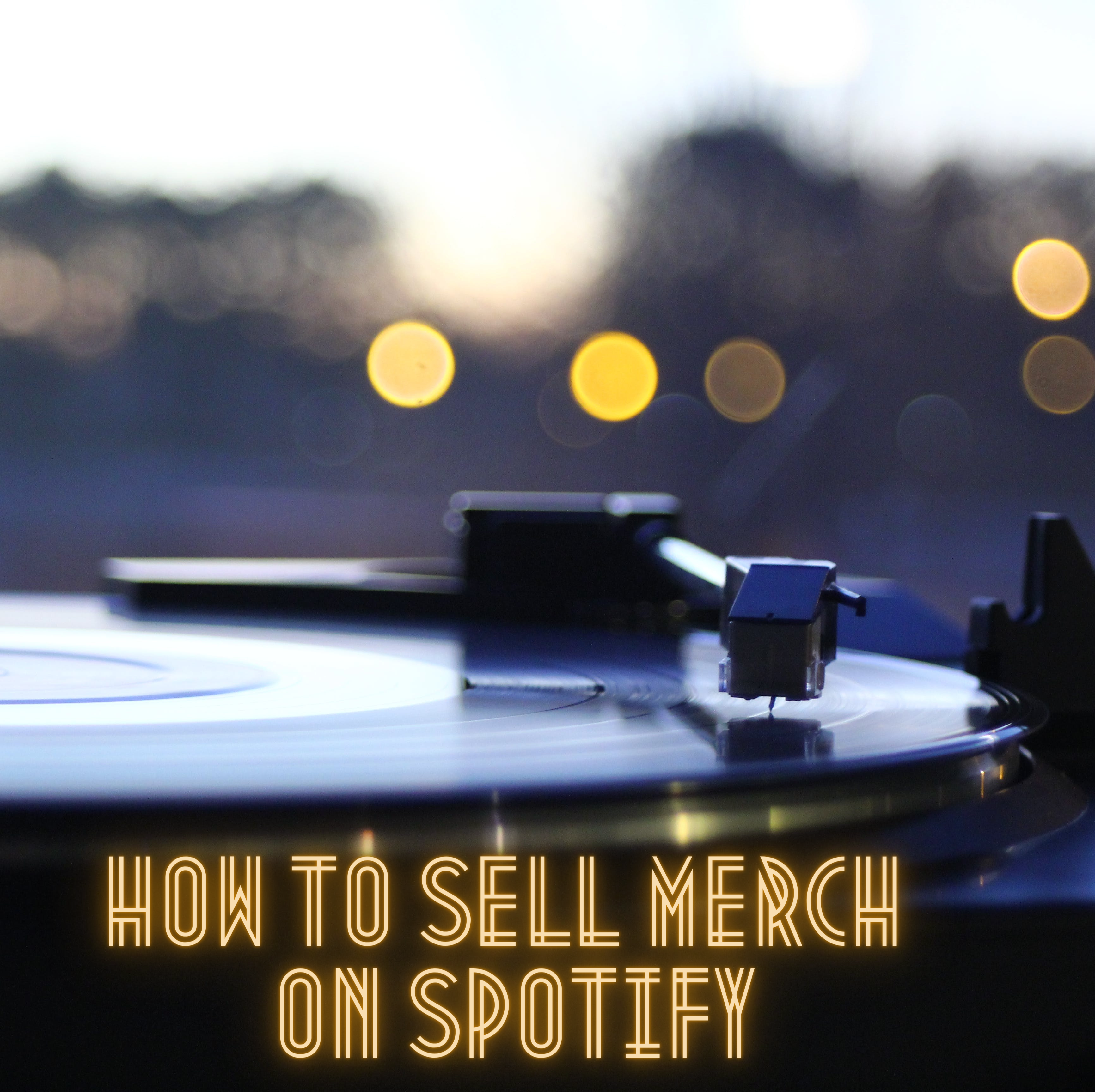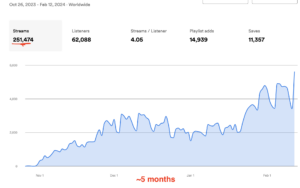Maybe I’m late to the party, but it was recently brought to my attention that Spotify – that often dubious, occasionally delightful platform that has the music industry in its death grip and grossly underpays artists but still somehow can’t seem to chart a viable course towards profitability – has more than one trick up its sleeve: as of 2014 (again, my invitation to this party was lost in the mail), artists can use its dusty, green-and-black corridors to hawk their merchandise.
The way the whole thing works has changed a bit over the years (they recently launched a hub, in fact), but as it turns out it’s all fairly straightforward, and there’s even a certain logical symmetry to it; after all, in terms of sheer numbers (user base, market share, etc.), Spotify is the number one streaming service, and the more features it can offer to its artists, the more it can tighten that death grip and hold onto that title. The Hotel California had a similar check-out policy, if memory serves.
That’s enough doom and gloom, though, and in this case we’re probably better off loving the devil we know than the one we don’t; as long we’re stuck with Spotify, it’s hard to see providing artists with an additional platform to sell merchandise – one directly adjacent to their songs, no less – as anything but a net benefit. To be sure, it’s no act of pure benevolence, but Spotify doesn’t take a cut of sales (for now, at least), so if you’re an artist with goods to sell, you’ve got very little to lose by adding this particular sales pipeline arrow to your…sales pipeline quiver.
You won’t lose nothing, though: as I’ll explain below, the privilege of selling merch on Spotify will set you back, at minimum, five dollars a month, although that money isn’t going where you think.
My Experience
How do I know so much about this?
Well, this very afternoon, I went through the whole process myself.
And now here I am: just a boy, standing in front of the internet, asking it to listen to me. I try not to talk about myself much in these articles – that’s not what I’m here for – but it feels relevant this time, so here’s a quick summary: I record and release music as The Wirelight, it is by no stretch of the imagination my full-time job or career, I spend tremendous amounts of time and money on this glorified hobby and take it very seriously, and I have a closet full of unsold vinyl left over from my last two album releases. All that being the case, and especially given that my most recent album came out last week and contains a single doing unusually decent streaming numbers, I was pretty amped to try and get the new vinyl in the closest possible proximity to the single in an effort to conjure up some synergistic musical mojo.
And I have good news, friends: it was easy.
Before I got started, I did some preliminary googling, and as is nearly always the result of preliminary googling, I quickly stumbled across hordes of angry internet people. Subreddits decrying Spotify’s merch platform as “spectacularly broken.” Articles positing conspiracy theories that Spotify launched an intentionally faulty system to somehow further screw over starving musicians, that it’s all a scam. As is also often the case with angry internet people, though, they were wrong (or, at least, the faulty system has been fixed and the conspiracy theories have faded a bit). I had records advertised for sale on Spotify within two hours, and most of that time was spent waiting for Spotify to finish processing my changes and actually populate my profile.
How Does it Work?
I won’t bury the lede any longer, though; here’s how it works. (You know those online recipes that make you read thirty pages about the author growing up in Indiana and cultivating muscadine grapes with grandma and grandpa before finally providing “Two Easy Steps” for frying an egg? Those are the worst.)
PS: I’ve been assuming you already have a Spotify account and some original songs uploaded. If you don’t, this guide can help you cross that preliminary threshold.
Get Merch
First, take a second and look around your room.
Do you see any merchandise? You’re gonna need that. If you don’t see any merchandise, create some.
The usual, obvious restrictions apply (no weapons, drugs, porn, etc.), but other than those, Spotify will let you sell pretty much any variety of merchandise you can come up with. In fact, one of the examples they tout as majorly successful is an artist who sold through a limited run of handmade jewelry in a matter of hours; that strikes me as a bit Etsy, but hey – if it works, it works. Think vinyl, trucker hats, t-shirts, stickers…whatever you think might get your audience salivating. For the record (ha!), I’m selling records.
Create a Spotify Account
Second, you’ll need to head on over to Shopify (that’s Shopify, not Spotify) to create yourself a new account.
If you already have one, great; you can use that. If not, though, and assuming your only goal for the moment is to sell merch on Spotify, the easiest road to success is to enroll in the “Starter” program for five bucks a month. If you’re a new Shopify user like me, you should find yourself eligible for the “get your first 3 months for $1/month” promo, which makes the whole piling-on-additional-monthly-recurring-subscriptions thing slightly more palatable, at least in the short term.
Once your account is created, Shopify is going to throw a whole lot of set-up prompts your way, and while it’s to Shopify’s credit that they’re capable of managing such complex store configurations, I found that, for my purposes and likely yours, the only items you need to address to get your goods on Spotify are as follows:
1) upload listings (price, description, etc.) for each item you have available for purchase;
2) set your shipping preferences (Protip: if you’re selling records, you can ship those via USPS’s “Media Mail” option, which is much cheaper than regular mail but will require you to add a custom shipping option); and
3) connect your bank account so that you have a repository for those sweet, sweet dollars once they start inevitably piling up. Everything else is optional and can be safely relegated to the “there if you need it” category.
Link Your Spotify Account
Now that you have a Spotify and a Shopify account, we need to get them talking to each other. At the bottom of the left-hand column of your Shopify dashboard is a link to “Apps;” follow that link, search for “Spotify for Artists,” and follow the instructions to link up your Spotify for Artists account (you do have one of those, don’t you?) to Shopify.
With that done, you’ll likely to have wait a few hours for Spotify to populate your profile with the new merch (this part took about three hours for me), so go make yourself a pot of tea, drink it, make another pot of tea, drink that too, probably use the bathroom, and then go hop over to your Spotify for Artists profile and see what’s what. Your newly uploaded and linked merch listings should now be showing up in the “Merch” section, accessible as always from the left-hand column.
Expert-Level Tweaks
You’re technically done at this point, but I took a few extra minutes to finagle some recommended customizations, and I think you should too. One of these is to highlight your most tantalizing merch option as an “Artist Pick” at the top of your Spotify page. You may have done this in the past with new singles or even songs you like by other artists, but it’s just as easy to use this little section to push your wares, and you might as well.
The other customization I like allows you to control where your merch actually appears on your profile; if you click “Manage Item” on a piece of merch from your Spotify for Artists Merch page, you can pin that item to the list of merch on your profile page so that it shows up permanently (rather than requiring visitors to navigate to your store to see it), and you can additionally tag that item to link it to certain music releases (ie, if you click on my newest album, the vinyl for that album is prominently featured alongside the songs themselves). That last feature may be most useful to those of us selling records, but I’m sure there are other ways to get creative with it.
There are a few other things to be aware of, although I haven’t explored them in depth personally: there’s the generalized “Merch Hub” I mentioned earlier that’s accessible from the “Browse all” section of Spotify’s search page and aggregates all the available merch from artists you follow or listen to most often. Currently featured in my Merch Hub are a “Taylor Swift Midnights Tea Cup Set,” my own vinyl, and an orange 3Oh!3 beanie, among various and sundry other tempting offerings.
Also, for the merchandise-deficient among us, Spotify has a partnership with a company called Printful, which company appears to offer design and marketing tools for basic merch items and also to manufacture those items on demand (in other words, when an order is placed), presumably so that musicians such as myself don’t wind up inundated with unsold inventory. Seems cool in theory, at least.
Worth it?
You’re probably wondering how I’m feeling after having done all of this myself. Was it worth it? Should you do it? Do I have any records left?
Your mileage may vary, but I found the whole process to be super easy, and while I do still have (plenty of) records left to sell, it brings me some level of peace to know that those records are now available right next to their digital counterparts rather than exclusively in some distant corner of the internet. If the goal is to sand down the surface of the casual-listener-to-potential-customer pipeline until it’s as smooth as possible – and from a business standpoint, it’s fair to say that should be the goal – then getting your merch up on Spotify ASAP is well worth the minimal time and trouble.
Now, whether it’s worth paying Shopify five bucks a month for the rest of your natural life, particularly if you’re not actually moving much of that merch, is a slightly different question, but that one’s for you to figure out.









